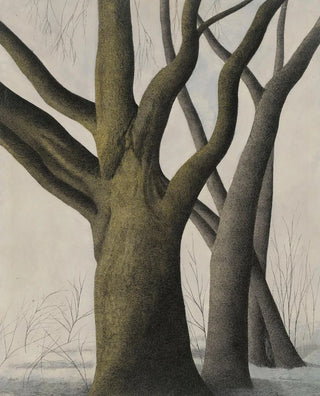Art print | Large Tree - Léon Spilliaert


View from behind

Frame (optional)
Art print Grand arbre - Léon Spilliaert – Engaging Introduction
In the vast realm of art, some works manage to capture the very essence of the human soul. "Grand arbre" by Léon Spilliaert is one such creation that, through its depth and uniqueness, invites introspective reflection. This painting, imbued with a mysterious atmosphere, evokes interior landscapes as well as external realities. Through its nuances and shapes, Spilliaert transports us into a universe where nature and spirit intertwine, revealing complex emotions and profound thoughts. This piece, far more than a simple representation of a tree, becomes a symbol of the quest for meaning and beauty in a world often chaotic.
Style and uniqueness of the work
Léon Spilliaert's style is undeniably distinctive, blending influences of symbolism and expressionism. In "Grand arbre," the artist plays with shadows and lights, creating an ambiance that is both serene and unsettling. The sinuous lines of the tree, almost anthropomorphic, seem to stand as a silent guardian of nature's secrets. The color palette, dominated by dark shades and luminous highlights, contributes to the enigmatic atmosphere of the piece. Every brushstroke reveals an intention; every detail is carefully thought out, inviting the viewer to immerse themselves in a silent dialogue with the canvas. This painting is an invitation to contemplate, feel, and interpret, making each gaze a unique experience.
The artist and his influence
Léon Spilliaert, born in Belgium in 1881, is often regarded as one of the pioneers of modernism. His career, marked by a constant search for authenticity and emotion, was influenced by the landscapes of his youth and the artistic movements of his time. Spilliaert distanced himself from academic conventions to explore themes related to isolation, solitude, and connection with nature. His work, often introspective, resonates with the existential concerns of the modern man. By integrating elements of nature into his compositions, he manages to establish a link between

Matte finish

View from behind

Frame (optional)
Art print Grand arbre - Léon Spilliaert – Engaging Introduction
In the vast realm of art, some works manage to capture the very essence of the human soul. "Grand arbre" by Léon Spilliaert is one such creation that, through its depth and uniqueness, invites introspective reflection. This painting, imbued with a mysterious atmosphere, evokes interior landscapes as well as external realities. Through its nuances and shapes, Spilliaert transports us into a universe where nature and spirit intertwine, revealing complex emotions and profound thoughts. This piece, far more than a simple representation of a tree, becomes a symbol of the quest for meaning and beauty in a world often chaotic.
Style and uniqueness of the work
Léon Spilliaert's style is undeniably distinctive, blending influences of symbolism and expressionism. In "Grand arbre," the artist plays with shadows and lights, creating an ambiance that is both serene and unsettling. The sinuous lines of the tree, almost anthropomorphic, seem to stand as a silent guardian of nature's secrets. The color palette, dominated by dark shades and luminous highlights, contributes to the enigmatic atmosphere of the piece. Every brushstroke reveals an intention; every detail is carefully thought out, inviting the viewer to immerse themselves in a silent dialogue with the canvas. This painting is an invitation to contemplate, feel, and interpret, making each gaze a unique experience.
The artist and his influence
Léon Spilliaert, born in Belgium in 1881, is often regarded as one of the pioneers of modernism. His career, marked by a constant search for authenticity and emotion, was influenced by the landscapes of his youth and the artistic movements of his time. Spilliaert distanced himself from academic conventions to explore themes related to isolation, solitude, and connection with nature. His work, often introspective, resonates with the existential concerns of the modern man. By integrating elements of nature into his compositions, he manages to establish a link between






